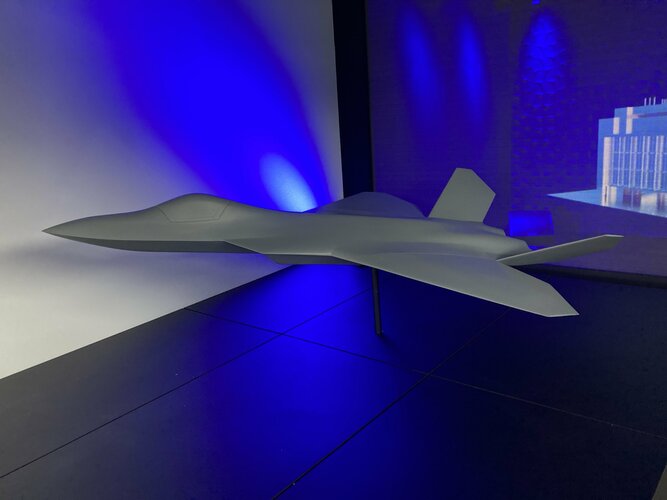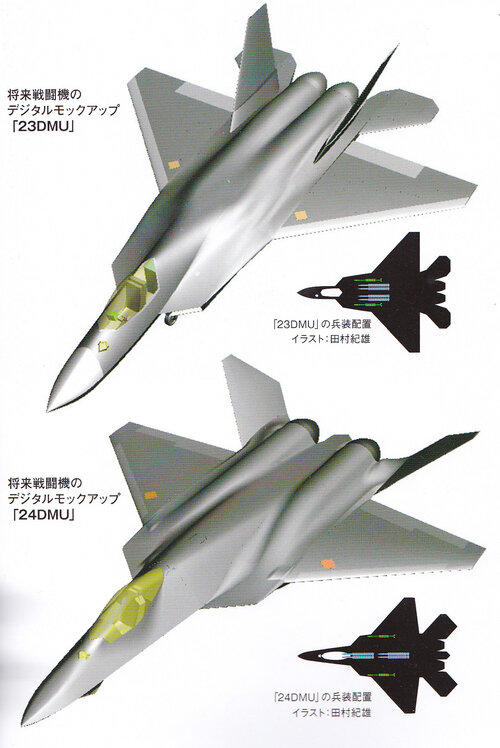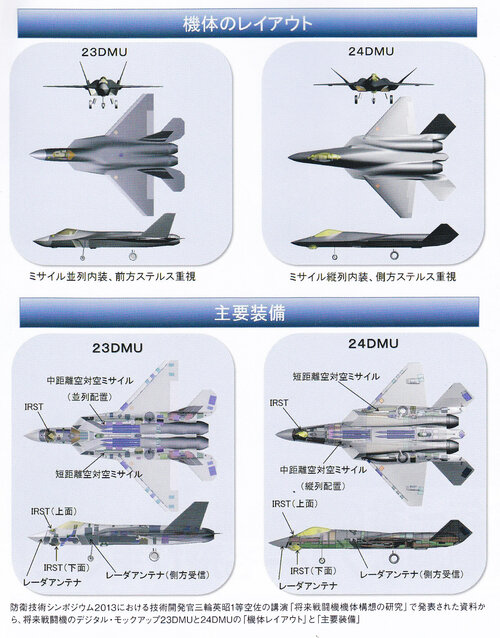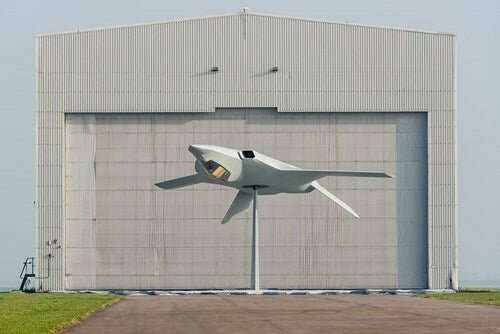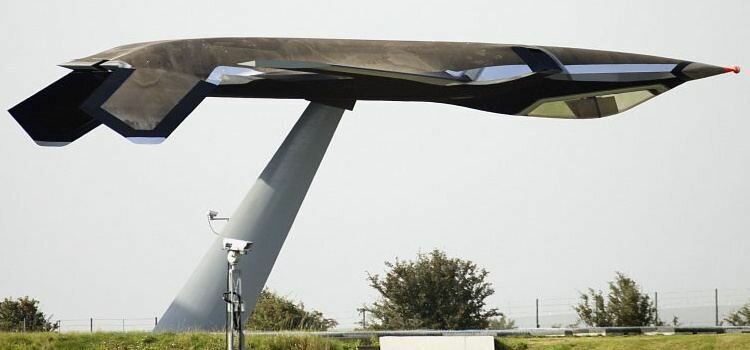You are using an out of date browser. It may not display this or other websites correctly.
You should upgrade or use an alternative browser.
You should upgrade or use an alternative browser.
BAe Tempest and other pre-GCAP studies
- Thread starter fightingirish
- Start date
red admiral
ACCESS: Top Secret
- Joined
- 16 September 2006
- Messages
- 1,805
- Reaction score
- 2,377
I suppose it depends what is actually being demonstrated this time to see whether it's similar difficulty/ complexityWasn't EAP much simpler with more modest ambitions?
- Joined
- 23 August 2011
- Messages
- 1,610
- Reaction score
- 4,772
The JAGUAR development has been fairly well covered and MBDA have shown quite a few concepts in recent years, usually around the Tempest mockup.We've not heard anything much on the radar and weapons systems
Ares
Man from Far East
- Joined
- 15 October 2018
- Messages
- 102
- Reaction score
- 454
Leonardo, Mitsubishi Electric Advance Joint Tempest Radar Work | Aviation Week Network
British and Japanese engineers are advancing work on advanced antenna that could form basis of future Tempest radar.aviationweek.com
British and Japanese engineers are advancing work on an advanced antenna that could form the basis of the future radar for the UK-led Tempest crewed combat aircraft.
As the two nations eye further cooperation on development of the crewed combat aircraft, Leonardo UK and Mitsubishi Electric (MELCO) have agreed on the concept for the Jaguar—Japan and Great Britain Universal Advanced RF (Radio Frequency)—radar technology demonstrator.
Work on Jaguar builds on Leonardo’s initial work on its Multi-Function Radio Frequency System (MRFS) for Tempest and the broader Integrated Sensing and Non-Kinetic Effects (ISANKE) system that will integrate Tempest’s defensive aids suite, infrared search-and-track and electronic support measures to work together through an advanced form of data fusion.
The Jaguar program aims to deliver more powerful sensing and processing capabilities as a proportion of its size compared to previous generations of radar.
Leonardo says the Jaguar work represents the “first big building block of an international radar program” that meets the ambitions laid out by Japan and the UK as part of F-X/ Future Combat Air System (FCAS) discussions.
The UK and Japan are also exploring engine development cooperation through joint work by Rolls-Royce and IHI Corp.
“With Jaguar we are trying to achieve high power, miniaturization and digitalization of the antenna head,” Andrew Howard, Director of Major Air Programs at Leonardo UK tells Show News.
“We will be making more use of the space, processing more information with more power so the outcomes achieved by MRFS will be substantially greater than what has gone before,” Howard says.
The announcement at Farnborough is the first acknowledgement of Mitsubishi Electric’s role in Jaguar. The Japanese company already has considerable experience in the development of active, electronically scanned array (AESA). MELCO developed the J/APG-1 AESA for the Mitsubishi F-2 fighter, the first such radar used in a fighter.
“Japanese industry’s approach to radar technology has been extremely complementary,” adds Howard.
Key to the work is using materials in different ways and places, Howard says, and the teams are using space available to secure the most capability for the available room devoted to the radar.
Leonardo UK says its relationship with Mitsubishi Electric has been deepening for several years and the partners are exploring the feasibility of further ISANKE-related subsystems collaboration throughout 2022.
Jackonicko
ACCESS: Secret
- Joined
- 4 February 2009
- Messages
- 386
- Reaction score
- 907
Britain said on Monday it was collaborating with Japan and existing partner Italy on its next-generation fighter jet programme, with joint concept analysis expected to lead to decisions on deeper partnerships by the end of the year.
British Prime Minister Boris Johnson said his government was backing aviation and technology.
"I am a passionate believer in the potential of our burgeoning partnership, not just with Italy, but with Japan," he said at the opening of the Farnborough Airshow.
Richard Berthon, UK Director, Future Combat Air, said Britain was talking to "serious countries with serious ambitions to invest".
He said talks with Japan were "going better than to plan".
"The extent of the alignment we found with Japan, both on the military side, on the engineering side and on the investment side is fantastic," he told reporters at Farnborough.
Still under negotiation.
Nope: I'm VERY reliably informed that both Reuters and the Times simply got it wrong. There is no intention on either side to merge programmes.
J
red admiral
ACCESS: Top Secret
- Joined
- 16 September 2006
- Messages
- 1,805
- Reaction score
- 2,377
djfawcett
With Enough Power, Anything Will Fly
- Joined
- 16 December 2012
- Messages
- 274
- Reaction score
- 422
This a bit of a misleading example. Boeing "low balled" the proposal in hopes of making its profit on the backside - support, etc. This further evidenced in that Boeing is loosing their butt on the development side.he potential for these innovative design and engineering approaches to significantly reduce the time it takes to develop, design, test and deliver complex combat aircraft was demonstrated by Boeing and Saab on their T-7A programme, where they were able to produce a new, clean-sheet-of-paper-design that met all Key User Requirements, and did so while beating existing in-service competitors on price, and in the same timescale!
Jackonicko
ACCESS: Secret
- Joined
- 4 February 2009
- Messages
- 386
- Reaction score
- 907
"I don't suppose you asked for any evidence about these claims?"I don't suppose you asked for any evidence about these claims?This demonstrator will not be a prototype in the traditional sense, as the design can and will continue to evolve. This is possible because so much development, design and testing can be carried out rapidly and efficiently in the virtual world, using synthetic modelling and model-based systems engineering. This means that the traditional ‘metal bashing’ and flight test phases of the project can be telescoped into a much shorter time frame. This in turn means that quite major design decisions can be left much later than would be the case in a traditional programme.
"Digital" has meant to be faster for decades now but experience with real programmes shows that the claims don't stack up. Even when you look at things like T-7 and MQ-25/28 and compare against previous programmes.
E.g. this 5 years to Tempest demonstrator is slower than EAP
This basically just seems to be industry hoping it'll be better this time so can get a nice development contract.
Where's the analysis? Hard questioning?
You assume wrongly, and, if I might say, rather rudely.
"Where's the analysis? Hard questioning?"
Again, that seems a little rude and unnecessarily confrontational. Have I pissed on your chips at some point in the past? If so, I hope it wasn't on the one on your shoulder! (I'd put a smiley emoticon here, if I knew how/could be arsed).
It's a much more complex undertaking than EAP was - to be fair, but the intent has always been to keep the design 'unfrozen' until the very last moment, and to deliberately spend far longer refining technology and iterating the requirement. My evidence is what senior programme personnel have told me over the last five or six years, from Michael Christie up, and down, and from his opposite numbers in BAE, in the RCO, in Leonardo, and in MBDA and Rolls. If anything, the surprising thing is that they're going to fly something a full eight years before ISD. The belief is that the sooner you freeze the design, the sooner it starts to become obsolescent!
I have probed this rigorously and relentlessly - because like you, I'm a bit of a dinosaur and I'm used to how long DT&E takes using the existing model, how long tunnel testing takes, how long concepting and OR have taken in the past, and I'm not used to the idea that using computational fluid dynamics allow multiple concept configurations to be exhaustively analysed very quickly. How quickly they can run uber-complex operational modelling, etc.
It surprised me that Saab and Boeing could undercut the M-346 and the T-50 with a clean sheet T-7A design, but thanks to these kind of techniques, they did.
Hard questions have been asked, especially by guys like Linc Taylor, and Gerry Mayhew.
I posted this little story on here the very minute that the embargo expired, and did so as a goodwill thing for fellow enthusiasts, unpaid. I don't expect people to prostrate themselves in gratitude, but I would have expected a modicum of politeness. The analysis will follow, elsewhere, for paying customers.
red admiral
ACCESS: Top Secret
- Joined
- 16 September 2006
- Messages
- 1,805
- Reaction score
- 2,377
Apologies, wasn't meant that way
F-35 was meant to be digital too - maybe we're just hoping it'll be better this time
Sure tools run faster on better computers, but design is done by people
This is the sort of analysis I'm on about. Boeing winning was because they underbid not because of digital guff. They wrote off hundreds of millions when they won and have continued to write off. On the timescale front it doesn't look like there's any advantage. And still encountering major issues in test. Where's the advantage?It surprised me that Saab and Boeing could undercut the M-346 and the T-50 with a clean sheet T-7A design, but thanks to these kind of techniques, they did.
F-35 was meant to be digital too - maybe we're just hoping it'll be better this time
Sure tools run faster on better computers, but design is done by people
Jackonicko
ACCESS: Secret
- Joined
- 4 February 2009
- Messages
- 386
- Reaction score
- 907
That's not the case. By using Saab's digital engineering models, methods and toolsets, Boeing stripped massive amounts of time out of the process of design and development. Everything fitted right, first time. No wiring radiuses turned out to be wrong, Sub assemblies lined up. Structural and aerodynamic testing was streamlined and accelerated. They achieved milestones without throwing much resource at the programme. They weren't in a hurry, but they needed to hit the KURs and they needed to bring the jet in at a competitive price.
They did then underbid, just as they did on KC-46, but that wasn't down to the 'digital guff'.
Senior engineers from a host of companies have reached the same conclusion about what happened on T-7A.
I trust their judgement.
They did then underbid, just as they did on KC-46, but that wasn't down to the 'digital guff'.
Senior engineers from a host of companies have reached the same conclusion about what happened on T-7A.
I trust their judgement.
Jackonicko
ACCESS: Secret
- Joined
- 4 February 2009
- Messages
- 386
- Reaction score
- 907
It's not about better computers, it's about doing things in a totally different way. It's the digital twin writ large.Apologies, wasn't meant that way
This is the sort of analysis I'm on about. Boeing winning was because they underbid not because of digital guff. They wrote off hundreds of millions when they won and have continued to write off. On the timescale front it doesn't look like there's any advantage. And still encountering major issues in test. Where's the advantage?It surprised me that Saab and Boeing could undercut the M-346 and the T-50 with a clean sheet T-7A design, but thanks to these kind of techniques, they did.
F-35 was meant to be digital too - maybe we're just hoping it'll be better this time
Sure tools run faster on better computers, but design is done by people
- Joined
- 15 July 2007
- Messages
- 4,887
- Reaction score
- 4,552
It all depends on compatibility.
Model A in simulation A tests aerodynamics
Model A is ported over to structural simulation B
Model A then goes to Radio simulation C
Then it gies through anthropometric analysis tool D
You get the picture I take it.
Then say take main spar and rapid prototype, insert in test gear and compare results.
And so on.
Model A in simulation A tests aerodynamics
Model A is ported over to structural simulation B
Model A then goes to Radio simulation C
Then it gies through anthropometric analysis tool D
You get the picture I take it.
Then say take main spar and rapid prototype, insert in test gear and compare results.
And so on.
red admiral
ACCESS: Top Secret
- Joined
- 16 September 2006
- Messages
- 1,805
- Reaction score
- 2,377
I don't doubt there are some real improvements in some areas e.g. robotic assembly, no shims etc. but how much does this actually feed up into top-level time/cost savings? Is it even on the critical path?
Looking back at T-7 timescales it's pretty difficult to see any programme-level time savings compared to similar types.
Is the real benefit from digital guff increased maturity / technical risk reduction?
Looking back at T-7 timescales it's pretty difficult to see any programme-level time savings compared to similar types.
Is the real benefit from digital guff increased maturity / technical risk reduction?
djfawcett
With Enough Power, Anything Will Fly
- Joined
- 16 December 2012
- Messages
- 274
- Reaction score
- 422
The real advantage are the new integrated high fidelity analysis programs - i.e. - CFD coupled with FEA, etc. The big gain is not some super 3d modeling program which has been around for many a year. Additionally, better networking interfaces improve productivity. But none of that won Boeing the T-7 contract. What won the contract was huge "low balling". Lets see how long it takes to recover the front loses with profits from the ultimate program support. ......... or which I suspect will happen, the unit price is going to scream skyward with a lot of crying and begging.
Guys I feel like we are increasingly getting off-topic... maybe we could continue the discussion on other threads as it's really interesting nonetheless. I suggest either :
T-7 thread (https://www.secretprojects.co.uk/threads/t-x-trainer-boeing-t-7a-red-hawk.13751/page-28)
or the
aircraft design software and tools thread (https://www.secretprojects.co.uk/threads/aircraft-design-software-and-tools.37951/#post-527820)
thoughts? If that sounds okay and the staff members feel alright, may I ask you to move the previous posts to the said thread as well?
T-7 thread (https://www.secretprojects.co.uk/threads/t-x-trainer-boeing-t-7a-red-hawk.13751/page-28)
or the
aircraft design software and tools thread (https://www.secretprojects.co.uk/threads/aircraft-design-software-and-tools.37951/#post-527820)
thoughts? If that sounds okay and the staff members feel alright, may I ask you to move the previous posts to the said thread as well?
Jackonicko
ACCESS: Secret
- Joined
- 4 February 2009
- Messages
- 386
- Reaction score
- 907
Team Tempest estimate that it will increase maturity and immeasurably reduce risk, but more prosaically they also believe that it will allow a programme that would have taken 20 years in days gone by to take ten - and it's a much more complex programme. (That's from the end of concept and assessment to ISD - 2025-2035).I don't doubt there are some real improvements in some areas e.g. robotic assembly, no shims etc. but how much does this actually feed up into top-level time/cost savings? Is it even on the critical path?
Looking back at T-7 timescales it's pretty difficult to see any programme-level time savings compared to similar types.
Is the real benefit from digital guff increased maturity / technical risk reduction?
Typhoon's requirements were simple. Produce a Swing Role fighter that would do the AD job better than a Tornado F.Mk 3, and the A-G job better than a Jag, with the specific need to achieve a specified kill:loss ratio against a "developed Flanker" threat.
I can't even begin to describe the FCAS requirement in that many words!
Jackonicko
ACCESS: Secret
- Joined
- 4 February 2009
- Messages
- 386
- Reaction score
- 907
I don't think that's the thing to do - the methodology underpinning Tempest is absolutely key to understanding what the Tempest is trying to achieve and how. Passing reference to T-7A is just an illustrative example.Guys I feel like we are increasingly getting off-topic... maybe we could continue the discussion on other threads as it's really interesting nonetheless. I suggest either :
T-7 thread (https://www.secretprojects.co.uk/threads/t-x-trainer-boeing-t-7a-red-hawk.13751/page-28)
or the
aircraft design software and tools thread (https://www.secretprojects.co.uk/threads/aircraft-design-software-and-tools.37951/#post-527820)
thoughts? If that sounds okay and the staff members feel alright, may I ask you to move the previous posts to the said thread as well?
Team Tempest estimate that it will increase maturity and immeasurably reduce risk, but more prosaically they also believe that it will allow a programme that would have taken 20 years in days gone by to take ten - and it's a much more complex programme. (That's from the end of concept and assessment to ISD - 2025-2035).I don't doubt there are some real improvements in some areas e.g. robotic assembly, no shims etc. but how much does this actually feed up into top-level time/cost savings? Is it even on the critical path?
Looking back at T-7 timescales it's pretty difficult to see any programme-level time savings compared to similar types.
Is the real benefit from digital guff increased maturity / technical risk reduction?
Typhoon's requirements were simple. Produce a Swing Role fighter that would do the AD job better than a Tornado F.Mk 3, and the A-G job better than a Jag, with the specific need to achieve a specified kill:loss ratio against a "developed Flanker" threat.
I can't even begin to describe the FCAS requirement in that many words!
That also makes sense. Though I had a feeling that the discussion might build towards T-7 rather than anything Tempest. In that case, let's keep it , at least for now.I don't think that's the thing to do - the methodology underpinning Tempest is absolutely key to understanding what the Tempest is trying to achieve and how. Passing reference to T-7A is just an illustrative example.
Talking about the actual effects of digital twin(or digital guff, or whatever anyone calls it), let's compare the T-7 development to T-50 and M-346(or Yak/AEM-130).I don't doubt there are some real improvements in some areas e.g. robotic assembly, no shims etc. but how much does this actually feed up into top-level time/cost savings? Is it even on the critical path?
Looking back at T-7 timescales it's pretty difficult to see any programme-level time savings compared to similar types.
Is the real benefit from digital guff increased maturity / technical risk reduction?
So the development of T-50 (aka KTX-2 program) went as follows :
December 1992 - program officially started.
1993 - a year of conceptual design,
1994~1995 - 2 years of basic design. In 1994 it was decided that the KTX-2 was going to be supersonic.
1996~October 1997 - bureaucratic hurdles, mainly due to feasibility concerns. No progress during this period. Interestingly enough, Asian Financial Crisis hasn't delayed the program.
October 1997~onwards - system development/EMD phase
July~August 1999 - PDR, fixation of OML
August 2000 - CDR
October 2001 - roll out of first prototype
August 2002 - maiden flight
February 2003 - supersonic
2003 - system development complete, initial production
2005 - roll out of first and second mass production models, first aircraft handed over to ROKAF
T-50, according to KAI, was completely designed with CATIA from start to finish, since 1997. I think it makes it a perfect example of a trainer, supersonic aircraft designed with CAD before digital twin. Since the start of EMD phase, it took 4 years until roll out and 5 years until maiden flight.
Since I'm not as knowledgeable about M-346, I'll need to rely on Wikipedia and according to what's written on it, it also took Yak-130 5 years until first flight after start of EMD(1991 to April 1996). Imo what followed thereafter is a bit inappropriate to be directly used for comparison.
Compared to previous examples, T-7 first flew in December 2016, 3 years after Boeing and SAAB announced their cooperation.
By that measure, it indeed seems like digital twin has proven its effectiveness, undercutting T-50 and Yak/AEM-130 development cycle by 2 entire years. On the other hand, I've gotta note that T-50 didn't suffer any kind of serious issues like wing rock unlike T-7 during its development, but then again, T-50 was developed with a lot of GD/LM expertise, including design features which was inherited from F-16 as well as avionics with LM input. I'm not sure how much of the T-7 design has its connections to Gripen or Hornet, though compared to SC model 400, it seems to bear less influence from existing aircraft before it.
So I think it's safe to say that digital twin provides measurable design process streamlining/acceleration but has some questions to be answered concerning design risk management, though it is also important to note that it's been almost a decade since 2013 and significant portion of Tempest's designing phase will take place after a decade later than T-7's development.
ps. come to think of it, there was this (https://www.secretprojects.co.uk/threads/japan-partners-with-uk-to-study-future-fighter.28790/) instance 5 years ago. We came full circle
Last edited:
red admiral
ACCESS: Top Secret
- Joined
- 16 September 2006
- Messages
- 1,805
- Reaction score
- 2,377
I'm not sure this is a fair comparison as the initial demonstrators are not prototype standard and almost definitely had limited qualification, certification etc. Compare to the actual EMD prototypes where it's taken 4 years from an already flying design... Even with some COVID delay that's hardly half the time.Compared to previous examples, T-7 first flew in December 2016, 3 years after Boeing and SAAB announced their cooperation.
By that measure, it indeed seems like digital twin has proven its effectiveness, undercutting T-50 and Yak/AEM-130 development cycle by 2 entire years.
Then with more complex fighters which are software reliant... So how does digital engineering/twin help reduce software time/cost? As this has really what's been on the critical path recently.
Maybe the better evidence will be with the NGAD flying prototype whenever/if that gets released
Jackonicko
ACCESS: Secret
- Joined
- 4 February 2009
- Messages
- 386
- Reaction score
- 907
Like with Tempest, we're not comparing apples with apples.
With the T-50, KAI produced an F-16 based trainer, using the knowledge they'd gained building F-16s.
The T-7A was an all-new design with a more innovative and novel configuration.
The digital guff will deliver Tempest quicker than they delivered a non-digital Typhoon
With the T-50, KAI produced an F-16 based trainer, using the knowledge they'd gained building F-16s.
The T-7A was an all-new design with a more innovative and novel configuration.
The digital guff will deliver Tempest quicker than they delivered a non-digital Typhoon
- Joined
- 21 January 2015
- Messages
- 12,150
- Reaction score
- 16,354
And I guess you missed the bit where the country is currently looking for a new PM with all that entails for every aspect of government including defense. Especially if we end up with a PM with very different ideas to the current one and a very different cabinet and junior ministers.Britain said on Monday it was collaborating with Japan and existing partner Italy on its next-generation fighter jet programme, with joint concept analysis expected to lead to decisions on deeper partnerships by the end of the year.
British Prime Minister Boris Johnson said his government was backing aviation and technology.
"I am a passionate believer in the potential of our burgeoning partnership, not just with Italy, but with Japan," he said at the opening of the Farnborough Airshow.
Richard Berthon, UK Director, Future Combat Air, said Britain was talking to "serious countries with serious ambitions to invest".
He said talks with Japan were "going better than to plan".
"The extent of the alignment we found with Japan, both on the military side, on the engineering side and on the investment side is fantastic," he told reporters at Farnborough.
Still under negotiation.
Nope: I'm VERY reliably informed that both Reuters and the Times simply got it wrong. There is no intention on either side to merge programmes.
J
- Joined
- 6 September 2006
- Messages
- 4,834
- Reaction score
- 9,458
Some analysis from the Royal Aeronautical Society.
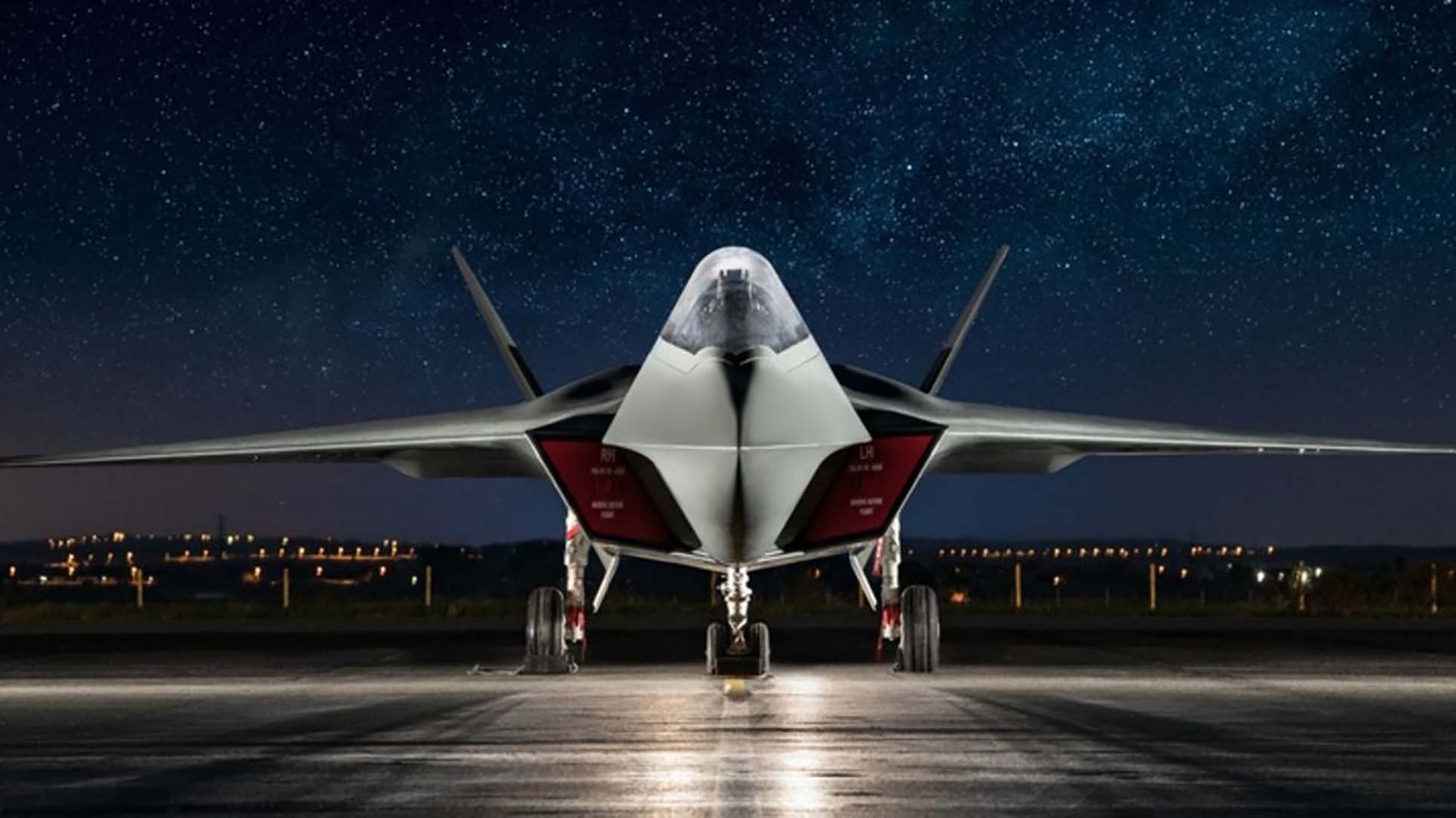
 www.aerosociety.com
www.aerosociety.com

Gathering storm - Royal Aeronautical Society
Four years on from the reveal of the UK’s ‘Tempest’ sixth-generation fighter project at Farnborough, TIM ROBINSON FRAeS catches up with progress on a future air combat system that is not only becoming more international but is rapidly shifting the workforce demographic to a younger, digital...
https://committees.parliament.uk/oralevidence/10546/html
Defence Committee
Oral evidence: Aviation Procurement, HC 178
Tuesday 28 June 2022
Ordered by the House of Commons to be published on 28 June 2022.
Members present: Mr Tobias Ellwood (Chair); Stuart Anderson; Dave Doogan; Richard Drax; Mr Mark Francois; Mr Kevan Jones; Gavin Robinson; John Spellar.
Questions 1 - 77
Witnesses
Dr Sophy Antrobus, Research Fellow, Freeman Air and Space Institute; Justin Bronk, Senior Research Fellow for Airpower and Technology, Royal United Services Institute.
Examination of witnesses
Justin Bronk: Sorry. In real terms, roughly speaking, on R&D and acquisition alone, not operating costs, Typhoon costs about £35 billion to £36 billion in today’s money as part of a consortium of four. That is about the entire air command budget for the next 10 years for Typhoon in real terms. Tempest is going to be far more complex, far more capable and far more lethal, and is being done as part of a smaller consortium with a lower aircraft number, inevitably, that are going to be made. The odds are that the costs are going to be higher because you are going for a much more complex and difficult thing.
There is a load of really good stuff being done on digital design, testing, manufacturing, new relationships with industry and being able to do things more quickly and efficiently. Even so, even with all that really important work that is going in, it would still be fairly amazing from an objective standpoint if they delivered Tempest for less in real terms than Typhoon cost us. Even if they did, where are you going to find £25 billion? That would be amazing. It would be £10 billion cheaper in real terms than Typhoon for a brand new aircraft suitable for the threats from 2040 to 2070. Where does that come from in a 10-year combat air budget of £21 billion to £22 billion?
Mr Francois: The MoD has told the Public Accounts Committee that it wants Tempest as a programme to be delivered far more quickly than Typhoon. It has made a direct comparison. It is intimating an IOC for Tempest of about 2035, which is quite aggressive. Let us assume for a moment that it is right. Surely, there is going to be no way that it can afford the Typhoons, an early battle Tempest and the 138 F-35Bs. The numbers just do not add up, do they?
Justin Bronk: No, they do not.
https://committees.parliament.uk/oralevidence/10462/html/
International Relations and Defence Committee
Uncorrected oral evidence: Defence concepts and capabilities: from aspiration to reality
Wednesday 15 June 2022
11.40 am
Members present: Baroness Anelay of St Johns (The Chair); Lord Alton of Liverpool; Lord Anderson of Swansea; Baroness Blackstone; Lord Campbell of Pittenweem; Baroness Rawlings; Lord Stirrup; Baroness Sugg; Lord Teverson; Lord Wood of Anfield.
Evidence Session No. 10 Heard in Public Questions 69 - 74
Witnesses
Air Marshal (Retired) Phil Osborn, Chief of Defence Intelligence (2015-18); Justin Bronk, Senior Research Fellow, Airpower and Technology, RUSI.
Justin Bronk: (snip) An NAO report in 2011 assessed Typhoon R&D and acquisition as £22.95 billion. If you adjust that for 2021 inflation, it comes to about £35 billion; it is probably significantly more now. Even if you assumed that all of the extremely important work being done in digital design development, testing and twinning shows that you can achieve things in a far shorter timeframe, and is significantly cheaper than in previous generations, and continues and delivers as expected, you are still asking for a much more capable and much more complex lethal and survivable system than Typhoon ever was, from a smaller consortium.
That would suggest that it would be a good day if it cost no more in real terms than Typhoon cost, eventually. Let us assume it costs far less than that. If all the stars align, let us say it costs £25 billion in today’s money. I still do not see where on earth that comes from. The air command budget is about £36 billion for the next 10 years, of which combat air is somewhere in the region of £21 billion or £22 billion. That includes any new F-35s, Protector, new radars for the Typhoon, and all sorts of things. The £2 billion currently sitting in strategic programmes, which is, I believe, £21.5 billion, includes all complex weapons as well as a whole host of other things.
The country can afford a new fighter; we have borrowed enough money to fund it many, many, many times over, much of which is unallocated, in post-Covid recovery funding for industry. The return on investment historically on domestic combat air development programmes, whether that be Typhoon, Tornado or Hawk, is somewhere between 3 and 4 to 1 over a 20-year period. It is generally a very efficient way to spend money because the Exchequer will get more back in the future, but that should not obscure the fact that it is directly taking money away from what the RAF and the broader Joint Force needs for control of the air over the next 15 years.
- Joined
- 6 September 2006
- Messages
- 4,834
- Reaction score
- 9,458
Also of note in that IRDC session on 15th June is that Air Marshal Phil Obsorn and Bronk condemn the (politically motivated it seems) reduced purchase of only three Wedgetails.
It makes you wonder on what sound basis the rest of FCAS as a network of systems will be depending on what level of crisis MoD funding will have gotten into in 15 years time. A cut price FCAS to afford an expensive fighter?
And Osborn doesn't seem to yet have much faith in the "digital guff":
It makes you wonder on what sound basis the rest of FCAS as a network of systems will be depending on what level of crisis MoD funding will have gotten into in 15 years time. A cut price FCAS to afford an expensive fighter?
Air Marshal Phil Osborn: [snip]
The fact that we are buying a very good airborne early warning and control platform, the E-7 Wedgetail, is a great thing. The current AWACS capability needs replacing. That we are buying only three is wholly inadequate; it is not enough to do the job. Even as part of a contribution from an international perspective, you could say something similar about a maritime patrol aircraft. I am not saying that you need more platforms like that; I am saying that you need to enhance the breadth of the capability that those platforms represent, and that brings you back to a mix of manned and unmanned.
To come back to your question, Lord Stirrup, yes, the logistics and stockpiles are absolutely taken as read. Then there are some key capabilities that are required to contest the air space, to give you the freedom to operate within it, and I have listed some of those.
Justin Bronk: I absolutely echo the E-7 point in particular. The provision of three aircraft for a mission that, by definition, requires significant time on station, is not only your linchpin for early warning and airborne command and control, but is your core networking node to connect all the different Joint Force communication elements together; for example, with Link 16 and E-3 previously in an area, an E-3 would typically be the gatekeeper and the network manager for Link 16. They are vital to have there, even if, in a contested environment, they are quite far back from the front lines; they are vital to have there, probably more so than anything, other than tankers.
The tanker fleet is excellent. If there are areas on which to commend long-term RAF planning, the MRTT fleet should be cited. It is notable that recently its flexibility was used to bring into service two of the aircraft that were not in regular use, but were part of the contract for provision, to compensate for the extra demand of operations in Romania and Poland.
Three aircraft for E-7 is about the most expensive way of failing to have an adequate capability. You are paying all the money for a superb aircraft, which incidentally the US Air Force has selected for its next AWACS as well, which is hugely useful. You will almost always have to plan on having one in deep maintenance of a fleet of three. I think the record for an E-7 flight is around 17 hours with air-to-air refuelling, but that is multiple crews; two crews on board rotating, you would hope.
It is certainly not sustainable to plan on those sortie lengths. To guarantee one AWACS orbit, which I believe is our minimum commitment to NATO on AWACS, you need at least three aeroplanes. If you have one waiting to be relieved on station and the other one develops a fault, which is incredibly common with aeroplanes, you simply do not have a capability. There is a reason why Sentinel was always kept at four as a minimum for ISR aircraft, and there is a reason why the requirement was written at five as the minimum.
The reduction to three, I understand, was partly a political intent to send a message to the RAF about budgetary responsibility and about being less optimistic about what it could do within given cost brackets. In light of the seriousness of the security situation in Europe, that is probably not a good position to hold on to. For example, an underspend purchase would be good to get another E-7, but, as we have seen before, underspend purchases sometimes lead to inadequate sustainment and logistics provision in the budget. They need at least one more E-7 just to make the fleet viable for maintaining one orbit where you need it.
And Osborn doesn't seem to yet have much faith in the "digital guff":
Is the digital guff really about shortening development times from a technical perspective or is it really a financial tool to maximise profits?Within that digital approach, there are probably two things that are most important from my point of view. The first is a business model, a finance model, that is much more a digital/finance model, with early investment delivering an early return on that investment. Then there is a requirement for a truly collaborative digital working environment across government allies and industry.
In the interests of brevity, I do not see sufficient momentum in both of those areas. That does not mean it is not irrecoverable. From an FCAS point of view, we should be looking very clearly at the business mechanisms by which you deliver the capability effectively, with perhaps a bit less focus, although we need to do the work, on the capability that it will bring.
And Osborn doesn't seem to yet have much faith in the "digital guff":
Is the digital guff really about shortening development times from a technical perspective or is it really a financial tool to maximise profits?Within that digital approach, there are probably two things that are most important from my point of view. The first is a business model, a finance model, that is much more a digital/finance model, with early investment delivering an early return on that investment. Then there is a requirement for a truly collaborative digital working environment across government allies and industry.
In the interests of brevity, I do not see sufficient momentum in both of those areas. That does not mean it is not irrecoverable. From an FCAS point of view, we should be looking very clearly at the business mechanisms by which you deliver the capability effectively, with perhaps a bit less focus, although we need to do the work, on the capability that it will bring.
Something like the one described in the 28 June 2022 transcript below does not boost your confidence in digital engineering.
(MP) Mr Francois: We went to Rolls-Royce at Bristol. We asked, “What is the real problem with the engine and the gearbox?” A Rolls Royce technician said, “When they designed it on a computer, it worked perfectly. When they built it, it didn’t.” The components in the gearbox keep burning themselves out, so they are forever having to take the engines, put them through deep maintenance and rebuild the gearboxes.
- Joined
- 29 September 2006
- Messages
- 1,794
- Reaction score
- 1,360
Francois is full of guff. I have no doubt that one of two things happened: either the technician explained the issue correctly, and Francois could not grasp it, or the technican dumbed down the answer for Francois - and Francois “sexed it up”.And Osborn doesn't seem to yet have much faith in the "digital guff":
Is the digital guff really about shortening development times from a technical perspective or is it really a financial tool to maximise profits?Within that digital approach, there are probably two things that are most important from my point of view. The first is a business model, a finance model, that is much more a digital/finance model, with early investment delivering an early return on that investment. Then there is a requirement for a truly collaborative digital working environment across government allies and industry.
In the interests of brevity, I do not see sufficient momentum in both of those areas. That does not mean it is not irrecoverable. From an FCAS point of view, we should be looking very clearly at the business mechanisms by which you deliver the capability effectively, with perhaps a bit less focus, although we need to do the work, on the capability that it will bring.
Something like the one described in the 28 June 2022 transcript below does not boost your confidence in digital engineering.
(MP) Mr Francois: We went to Rolls-Royce at Bristol. We asked, “What is the real problem with the engine and the gearbox?” A Rolls Royce technician said, “When they designed it on a computer, it worked perfectly. When they built it, it didn’t.” The components in the gearbox keep burning themselves out, so they are forever having to take the engines, put them through deep maintenance and rebuild the gearboxes.
red admiral
ACCESS: Top Secret
- Joined
- 16 September 2006
- Messages
- 1,805
- Reaction score
- 2,377
Got to wonder what orifice that rate of return is being plucked from. Works out as 6-7% annually or about as good as investing in the FTSE. BAES might as well self-fund if its that good.The return on investment historically on domestic combat air development programmes, whether that be Typhoon, Tornado or Hawk, is somewhere between 3 and 4 to 1 over a 20-year period. It is generally a very efficient way to spend money because the Exchequer will get more back in the future, but that should not obscure the fact that it is directly taking money away from what the RAF and the broader Joint Force needs for control of the air over the next 15 years.
Maybe including the 1000 sales of Hawk is a bit of an outlier compared to the others? Hmm
LightningFan1959
ACCESS: Restricted
- Joined
- 11 May 2020
- Messages
- 19
- Reaction score
- 40
A flying demonstrator aircraft will be unveiled within the next five years as part of the UK’s major next-generation fighter aircraft programme, the ‘Future Combat Air System’ (FCAS).
According to the Ministry of Defence, this comes as the future combat air programme launches a new recruitment and skills initiative known as Generation Tempest, set to create thousands of new job opportunities across the United Kingdom.
“The demonstrator aircraft is already in development between the Government and Team Tempest industry partners and the UK is actively progressing collaboration opportunities on the project with Italian industry partners. The flying demonstrator will be a piloted supersonic aircraft testing a range of new technologies including integration of stealth compatible features. This is the first time the UK will have developed a new fast aircraft using 21st century technology.
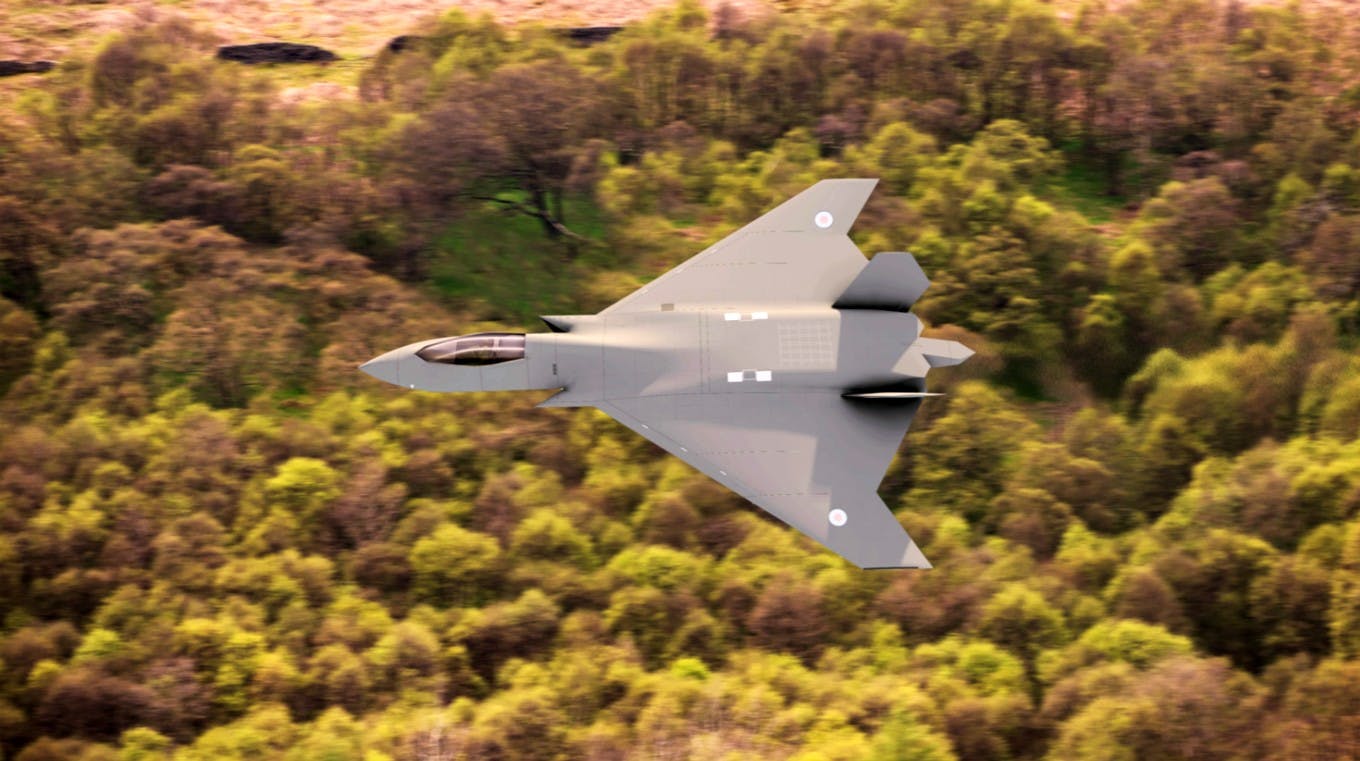
British ‘Tempest’ demonstrator jet to fly within five years
A flying demonstrator aircraft will be unveiled within the next five years as part of Britain's next-generation fighter aircraft programme.
 ukdefencejournal.org.uk
ukdefencejournal.org.uk
kaiserd
I really should change my personal text
- Joined
- 25 October 2013
- Messages
- 1,657
- Reaction score
- 1,726
Interesting that the only reference to Sweden was a quite an oblique one while the references to cooperation with Italy and Japanese a lot more numerous and specific.
May not prove to be particularly significant.
May not prove to be particularly significant.
Rhinocrates
ACCESS: Top Secret
- Joined
- 26 September 2006
- Messages
- 3,053
- Reaction score
- 7,781
Some changes in the latest display model. https://theaviationist.com/2022/07/19/fcas-announcements-fas/
Last edited by a moderator:
LightningFan1959
ACCESS: Restricted
- Joined
- 11 May 2020
- Messages
- 19
- Reaction score
- 40
It’s quite possible that Sweden are more of a secondary partner than a ‘primary’ one like Italy and Japan (especially if the programme merger goes ahead), and have signed on primarily with lessening system/development costs by means of international cooperation in mind (since it would be a lot cheaper than going it alone for a 6th generation jet fighter, all they’d really need to do would be airframe development).Interesting that the only reference to Sweden was a quite an oblique one while the references to cooperation with Italy and Japanese a lot more numerous and specific.
May not prove to be particularly significant.
Jackonicko
ACCESS: Secret
- Joined
- 4 February 2009
- Messages
- 386
- Reaction score
- 907
There's a lot more ongoing activity with Italy, and with Japan, and both of those nations have some interest in the core manned fighter, or its systems, whereas Sweden is primarily focused on the adjuncts and effectors.
From what I heard Sweden is more interested in using Tempest developments to augment their Grippen fleet with a main focus on the wingman drone.It’s quite possible that Sweden are more of a secondary partner than a ‘primary’ one like Italy and Japan (especially if the programme merger goes ahead), and have signed on primarily with lessening system/development costs by means of international cooperation in mind (since it would be a lot cheaper than going it alone for a 6th generation jet fighter, all they’d really need to do would be airframe development).Interesting that the only reference to Sweden was a quite an oblique one while the references to cooperation with Italy and Japanese a lot more numerous and specific.
May not prove to be particularly significant.
- Joined
- 29 November 2010
- Messages
- 1,775
- Reaction score
- 3,479
an updated Tempest configuration spotted at Farnborough air show
looks like the cockpit and nose were redone
wing changed. overall a bit more "conventional" looking than the last config
DSI gone (interesting many newer designs are no longer using DSI)
looks like the cockpit and nose were redone
wing changed. overall a bit more "conventional" looking than the last config
DSI gone (interesting many newer designs are no longer using DSI)
Attachments
Last edited by a moderator:
- Joined
- 29 November 2010
- Messages
- 1,775
- Reaction score
- 3,479
Looks like a combination of BAe's "Replica" and MHI's DMU24 plan from early F-X
you're right! always thought both 24DMU
and the Replica were aesthetically pleasing
except for the Replicas tiny radome. what's up with that?
the tail looks quite a bit like the replica as well.
Attachments
Last edited by a moderator:
- Joined
- 29 September 2006
- Messages
- 1,794
- Reaction score
- 1,360
The Bristol-Siddley infiltrators bided their time, but now the strike back begins!!Rolls-Royce Orpheus: Enjoy
Wtf
- Joined
- 15 July 2007
- Messages
- 4,887
- Reaction score
- 4,552
An assumption there's a radar there....or only there.except for the Replicas tiny radome. what's up with that?
Similar threads
-
UK-Japan-Italy Global Combat Air Programme (GCAP) News & Analysis
- Started by Deltafan
- Replies: 2K
-
MBDA Future Cruise / Anti-Ship Weapon (FC / ASW)
- Started by Triton
- Replies: 175


